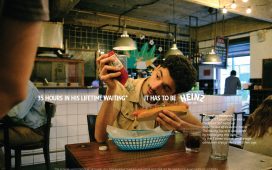More women in agencies and in higher creative positions could save the Middle East from itself. Here two creative directors talk gender and the challenging of stereotypes
The Middle East is busy producing talented women in every Arab city. Faster and greater than it is producing talented men. And this talent is affecting the creative communication industry. But not as quickly or as strongly as it should be.
Many clients in the region still want to see men in their meetings. In many cases, clients (sometimes women) request male voiceover talent to deliver their brand slogans because ‘men inspire more trust’. When a television commercial features a child, the child is usually a boy because it is the default choice. The industry is still producing commercials featuring women scrubbing, doing the dishes, and feeding their families with a big smile within the context of an overall archaic creative product.
This is the result of a male-dominated industry in a male-dominated society. While women in our societies are claiming their place as independent creative minds, the largest creative industry in the region still conforms to traditional paternal norms.
And this is not surprising. Men hold the chief executive and chief creative officer positions in all groups and in most agencies. And we can still see the majority of women limited to entry level and mid-level managers in most agencies. Major decision-making positions in the majority of agencies and groups are occupied by men, and most of the time, the same applies to clients.
This reality must, and will, surely change.
Davina Atallah, creative director, Leo Burnett Beirut
“I am relatively a newcomer to advertising. Six years ago I was working for a design house that was dominated by female creatives and designers. Working in Leo Burnett Beirut, I do not feel like much has changed. I do not feel like I am in a male-dominated environment. Our managing director is a woman. I am one of seven women in creative director positions. And the agency is predominantly composed of women. The Leo Burnett Beirut office has become famous for women’s rights campaigns, most probably because of its demographic structure and the amount of active women who work there. While agencies in Dubai, Saudi Arabia and Egypt may seem dominated by men in high positions, I do not feel that I am held back because of my gender.
“Communication agencies are constantly producing content with very high circulation and viewership – certainly a powerful force capable of affecting perception and society. And the traditional male-dominated industry has made clients and agencies alike accustomed to believing that some stereotypes are true, like objectifying women – a common trick believed to ‘sell’ more. Women in advertising agencies today take every client brief as an opportunity to challenge these stereotypes.
“For the longest time, women had been socialised to be the economically venerable caregivers, while men were the providers. This is certainly not the case anymore. However, all these years of preconditioning have allowed women to developed sharp sensitive skills when it comes to reading people, empathy, patience, resilience, and adaptability. Applying these skills in communication leads to more insightful briefs, more touching stories, and certainly less stereotypes that are taken for granted.
In short, more women in communication agencies could save the Middle East from itself.
“It’s not the women that changed. It’s the economic facts we live in that have changed the power dynamics in the work place and at home. Today men and women have to both work to make ends meet, and this forced couples to reassess the traditional criteria that define the main provider of the family. As a result, women – who are traditionally the caregivers – are becoming the providers as well. This is empowering women not only at home but in society as well, and forcing men to adapt to the idea that their manhood can no longer be defined by whether or not they are the sole providers for their families. In that sense, men have a bigger challenge than women.
“One industry at a time, the future of this region is very slowly moving into the hands of the strong confident women of today, and it looks promising.”
Summer Elbosraty, creative director, Memac Ogilvy Dubai
“We have done well yet we have a long way to go. There are lots of great campaigns being done by amazing female creatives in the region. Yet, unfortunately there is still a gender gap in the advertising industry in the Middle East. It has not progressed enough to foster a balanced ratio for many female creatives.
“Let’s step back and look at a neglected fact: women control around 80 per cent of consumer shopping. We need to understand them and their behaviour and no one understands a woman better than another woman. Don’t they say ‘women are complicated’? It would only take a few more in creative leadership positions to bring about a flood of other women.
“At the same time, I can’t blame the industry only. Some female creatives have this lingering doubt of ‘how can I be a mom and a creative director?’; ‘it’s a man’s world!’; and ‘the shelf life of a female creative is 10 to 15 years’. All of these factors might delay the impact of more women in senior creative positions. We need more Donna Drapers. More mad women.”









